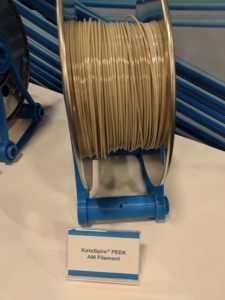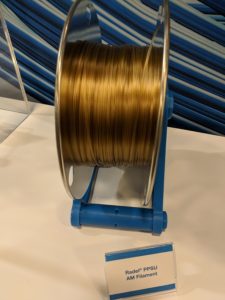We Need to Open Up This Industry to Deliver the Potential of Additive Manufacturing: A Conversation with Solvay
 Solvay has been advancing its presence in the additive manufacturing industry. The company, with a tagline of “asking more from chemistry,” recognizes the importance of 3D printing, as has been a rising trend among global chemical giants. During the recent RAPID + TCT, Solvay was announced as one of Ultimaker’s new industry partners for engineering materials, and had several announcements of its own as well. For more insights into the company’s strategies and approaches in 3D printing, I appreciated the opportunity to sit down with Christophe Schramm, Business Manager for Additive Manufacturing at Solvay’s Specialty Polymers global business unit.
Solvay has been advancing its presence in the additive manufacturing industry. The company, with a tagline of “asking more from chemistry,” recognizes the importance of 3D printing, as has been a rising trend among global chemical giants. During the recent RAPID + TCT, Solvay was announced as one of Ultimaker’s new industry partners for engineering materials, and had several announcements of its own as well. For more insights into the company’s strategies and approaches in 3D printing, I appreciated the opportunity to sit down with Christophe Schramm, Business Manager for Additive Manufacturing at Solvay’s Specialty Polymers global business unit.
“What’s exciting is that we’ve just launched the first high-performance filaments for FFF 3D printing, with PEEK, PPSU, and CF. Why? You’ll never get fired for selling PEEK,” he told me with a grin. “We know there are many applications out there that need PEEK. PPSU adds transparency.
“We see this as the first step to becoming the leading supplier of high-performance additive manufacturing materials. We want to develop an ecosystem for our customers.”
The three new materials — two leveraging Solvay’s KetaSpire PEEK polymer, one with neat PEEK and the other a 10% carbon fiber-reinforced grade; and one based on the company’s Radel PPSU — represent a step forward for high-performance 3D printing. PEEK (polyetheretherketone) and PPSU (polyphenylsulfone) are in-demand materials, with PEEK renowned for exceptional strength and layer fusion for high part density and PPSU offering high transparency, elongation, and toughness as a 3D printing material.
“3D printing of high-performance materials — not PA12 or PA66 — is a young industry with many pain points,” he continued.
“We believe we need to open up this industry to really deliver the potential of additive manufacturing; we’re focused on the convergence of high-performance polymers and additive manufacturing.”
Bringing specialty polymers technology more closely into the realm of additive manufacturing is a necessity for the future of industrial 3D printing. Polymers, which have been outpaced in growth by metals in additive manufacturing, remain by far the larger segment of the industry; enhancing portfolios of offerings with higher-performing formulations will provide a boost to polymer technologies. With an eye toward leadership, Solvay is shouldering the task of building up high-performance capabilities.
The company is already developing its next offerings, including an additive manufacturing powder based on its NovaSpire PEKK polymer. PEKK (polyetherketoneketone) is well-received in aerospace and healthcare applications.
“We’re working on next-generation materials, with AM-ready powders based on PEKK. We have been in these industries with these materials for injection molding for years and we want to bring that to AM,” Schramm continued.
Next we looked toward market approaches, as the all-important throughline of democratization is a major focus for Solvay.
One approach the company is taking is in its new e-commerce platform, which Schramm highlighted as an important differentiating factor with materials available from day one.
“We are the first to offer, on our own site, a place to buy materials with transparent pricing and full information availability. We’re addressing weak points of AM today. The webshop will grow into a place to not only buy spools, with platform services, linked to partners in our ecosystem, simulation, and more, so customers can find the best solution for them,” he told me.
 With the site serving as a portal to simulation, testing, and prototyping services that, the company notes, leverage its growing partner network and open ecosystem approach, the platform’s focus on customer experience is apparent. Direct access and clarity of available options allows for user-friendly navigation.
With the site serving as a portal to simulation, testing, and prototyping services that, the company notes, leverage its growing partner network and open ecosystem approach, the platform’s focus on customer experience is apparent. Direct access and clarity of available options allows for user-friendly navigation.
“We have the broadest range of high-performance polymers, with 35 polymer families,” Schramm noted of the company’s offerings. “We are enabling our portfolio for additive manufacturing, with services that are needed to print right — to print well.”
In addition to the materials and platform announcements, Solvay announced a partnership with e-Xstream, as KetaSpire PEEK filament is set to be the first PEEK polymer included in e-Xstream engineering‘s Digimat simulation software, set for a June launch. The companies have a long-standing partnership, and in Digimat 2018.1, Digimat for Additive Manufacturing allows for prediction of warpage and residual stresses for use of 3D printed KetaSpire PEEK parts.
“We have worked on our PEEK printed via FFF as a material you can simulate. Simulating model performance of your part helps you to get it right the first time. It’s very important to get the process right,” Schramm underscored.
As we discussed partnerships, Schramm noted the new Ultimaker initiative as being “part of that spirit of democratization of manufacturing” so important to Solvay’s current thinking — and to the 3D printing industry at large.
Partnerships are critical to industry advances, and Solvay is working to leverage expertise and add know-how as the market grows. Starting small is helpful, he noted, as Solvay is beginning with the three new materials and will learn from these before moving forward to more structural products, all with a view to help the industry toward maturation.
“We’re seeing more printers that can do high-temperature; there’s really progress in that space,” he continued.
 As business push boundaries with capabilities, Solvay is also dedicated to encouraging the same for the next generations of engineers and designers. The AM Cup, launched in the autumn, challenged university students to work with PEEK. For all its strength and high-performance qualities, PEEK so far remains a challenging material to use in additive manufacturing. Not only did student teams step up to the plate in creating complex designs 3D printed with PEEK, they exceeded expectations, Schramm told me.
As business push boundaries with capabilities, Solvay is also dedicated to encouraging the same for the next generations of engineers and designers. The AM Cup, launched in the autumn, challenged university students to work with PEEK. For all its strength and high-performance qualities, PEEK so far remains a challenging material to use in additive manufacturing. Not only did student teams step up to the plate in creating complex designs 3D printed with PEEK, they exceeded expectations, Schramm told me.
With “many impressive entries,” the winning entry solved the Z-axis problem, he noted. The winners of the AM Cup were announced at the end of March. In first place, team ePEEK from Arts et Métiers ParisTech 3D printed PEEK parts “that exhibited an exceptional tensile strength of 80 MPa in the z-axis, which is similar to injection molding,” Solvay said in the announcement.
Showcasing the capabilities of high-strength 3D printing in the AM Cup and working with partners has continued to motivate the team at Solvay to push toward leadership. In building its ecosystem, Schramm told me, the company is working with materials, process, and design to ensure these qualities “align to deliver on the promises of additive manufacturing.”
Solvay itself is seeing additive manufacturing operating within the company in a smaller business incubation unit that functions “with the mindset of a startup: flexible, agile, resource efficient,” he continued, which is a “very different mindset” compared to larger global operations. While outside the core business, operations are closely integrated, allowing for use of significant R&D resources while functioning with agility, he noted. This strategy is setting several major businesses up for success in additive manufacturing.
“We’re well set up now and ready for business,” Schramm concluded.
As more global chemical companies work to integrate additive manufacturing into business strategies, high-performance 3D printing serves to benefit from significant materials experience and expertise. Solvay’s focus on high-performance additive manufacturing ensures that the company remains one to watch.
Discuss Solvay, high-performance polymers, and other 3D printing topics at 3DPrintBoard.com or share your thoughts in the Facebook comments below.
[All photos: Sarah Goehrke]
Subscribe to Our Email Newsletter
Stay up-to-date on all the latest news from the 3D printing industry and receive information and offers from third party vendors.
Print Services
Upload your 3D Models and get them printed quickly and efficiently.
You May Also Like
Nikon SLM Solutions Sells SLM 500 to Primary Weapon Systems to Expand Suppressor Production
Primary Weapons Systems (PWS) is a Boise, Idaho-based manufacturer of suppressors, firearms, and related components. A subsidiary of Vigilant Gear and a sister company to aftermarket Glock slide manufacturer Lone...
3DPOD 261: Tooling and Cooling for AM with Jason Murphy, NXC MFG
Jason Murphy´s NXC MFG (Next Chapter Manufacturing) is not a generalist service; instead, the company specializes in making tooling. Using LPBF and binder jet, the company produces some of the...
HP and Firestorm Labs Form Partnership to Use Multi Jet Fusion 3D Printers in Deployable Factories
HP Inc., maker of a range of additive manufacturing (AM) solutions including the Multi Jet Fusion (MJF) ecosystem, has announced a partnership with Firestorm Labs, a developer of containerized, deployable...
3D Printing News Briefs, July 2, 2025: Copper Alloys, Defense Manufacturing, & More
We’re starting off with metals in today’s 3D Printing News Briefs, as Farsoon has unveiled a large-scale AM solution for copper alloys, and Meltio used its wire-laser metal solution to...







































